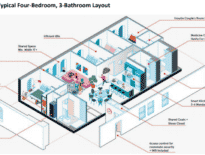Tracy Corley
Transit-Oriented Development Fellow, MassINC
Age: 46
Industry experience: 25 years
From Attleboro to Worcester, Dr. Tracy Corley helps Massachusetts’ Gateway Cities transform the way they do real estate and economic development. Before joining MassINC as their primary transit-oriented development researcher following the completion of a PhD in law and public policy, she spent the better part of two decades as an architect and business leader in Seattle, in addition to founding two consulting firms. She brings her expertise in real estate, business, law and sustainability to bear at MassINC. There, she convenes political and community leaders across the state to spur inclusive development in the state’s 26 Gateway Cities – mid-sized regional urban centers that have historically missed out on Greater Boston’s economic wins.
Q: What attracted you to focus on Massachusetts’ Gateway Cities?
A: As an urbanist, you’re talking about megacities, ones that are larger than Boston, and you forget about the small- and mid-sized cities. When I saw this opportunity, I thought this would be a great opportunity to redirect the focus on where many people actually work and live.
Q: Your CV prior to MassINC is an unusual one for a planner – architect, small business founder, researcher of informal work in the German skilled trades. How do these varied experiences inform your current work?
A: I put that interest and expertise to work in the consulting work that I did. When you’ve had a circuitous career, as I’ve done, you don’t often get a chance to apply all the experiences you’ve had. This work blends architecture, economic development, sustainable development. That’s the thing about transit-oriented development – you’re dealing with all of these components at once.
Q: What’s the coolest thing you’ve seen or experienced in a Gateway City since starting at MassINC?
A: Well, the coolest thing I’ve seen I can’t talk about until they make it public. That’s the hardest thing about this work!
When you’re in policy work or in planning, you’re taught that “This is the way cities work” or “This is the way economic development is done.” Our Gateway Cities are all defying the rules in their own ways. Our Gateway Cities recognize – and this was part of the work I was doing in Germany – successful companies are either building themselves into these mega–entities, or into smaller, distributed units.
Instead of trying to attract that one big employer that will employ thousands, our Gateway Cities are focused on attracting many small businesses and growing their own. What I’m seeing on the ground in our Gateway Cities, there are a lot of small wins. It’s that old adage of “saving your pennies” and compound interest will grow them into millions of dollars, instead of gambling for that million-dollar jackpot.
Q: Gateway Cities have a lot going for them, but often feel a bit left behind. What’s the biggest obstacle to fulfilling their development potential?
A: All of our Gateway Cities are very different. The one thing that I think unites them all is the stigma associated with them. The reputation – mostly undeserved – is the biggest barrier to attracting the resources they need to thrive. If you’re talking speculative capitalism, you have to feel good that the market’s going to turn around. If no one believes it, it becomes a self-fulfilling prophecy. Telling success stories, like how we have the country’s second-biggest supplier of high-end bridal gowns in Fall River, is important in shifting that narrative.
Q: Are the MBTA’s very visible struggles hurting this potential?
A: I have to say I don’t share your view of the MBTA. Like most cities across the United States, Boston just wasn’t prepared for the amount of growth that came, and the lack of investment – not just by the MBTA but by all state agencies and the federal government – outside of Greater Boston have made it very defunct for the region to function with all the jobs that have flooded in.
I’m finding [regional transportation authorities, or RTAs] are being very innovative about using what they have. Regional ballot initiatives, which would give regions the capacity to raise their own transportation funding, that is something that can help supplement what RTAs and local municipalities are doing right now. The base funding for RTAs also needs to be at least doubled, but with strong metrics in place that they’re moving people, not just moving vehicles.
Q: Traffic concerns dominate local opposition to development and up-zoning anywhere. What can towns – and developers – do to better address those?
A: Right now a lot of people, in our Gateway Cities in particular, don’t see an alternative to driving around, but if you have all the services within walking distance, and if you have reliable transit, you can get rid of your car. I did that when I lived in Seattle. I was putting less than 3,000 miles on my car each year and I found I didn’t need it.
One of the things I see that’s very problematic is in greenfield development, where developers are siting individual residential developments far away from other uses. When you have mixed-use, compact development, people can walk to the grocery store, to school, to high-frequency transit, you can dramatically reduce car traffic. You can also spend a lot less building parking because it’s less profitable, too. We have the mentality and the know-how to do things like that, but no one’s thinking beyond the 10-year [internal rate of return].
Q: What big opportunity are communities outside Boston not seizing right now?
A: We need to be thinking about how we put more commercial uses in our Gateway Cities, not just coffee shop retail jobs, so people are not having to drive or take the train 30 miles to work, or to appointments. One of the things I hear a lot about, actually, is a shortage of class A office space there. It’s not just about putting in housing, it’s not just about retail and fun entertainment districts, it’s making sure people have all the services they need in their communities. That’s how you mitigate traffic.
There is opportunity for regionalism that is not being taken advantage of across the state. That involves thinking about our Gateway Cities as the regional hubs they are, and better connecting suburban town centers and village centers with these cities through bus rapid transit or train service where that’s available.
Corley’s Five Most Awe-Inspiring but Crumbling or Destroyed Urban Places
- The Mendenhall Glacier as seen from Juneau, Alaska (melting)
- The Parthenon in Athens, Greece (pollution)
- Notre Dame’s rooftop sculptures and belltower, Paris (fire)
- World Trade Center towers and atrium, New York, NY (terrorist attack)
- Copacabana Beach, Rio de Janiero (pollution)
Updated 1:15 p.m., Jan. 6, 2020: This story has been updated to clarify the threats to items in Corley’s list of awe-inspiring urban places.




 |
| 


